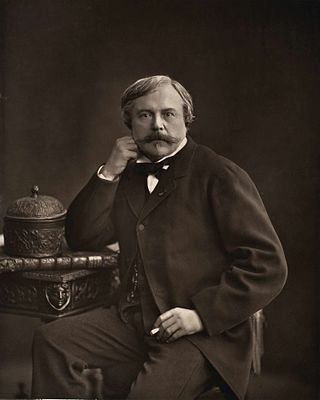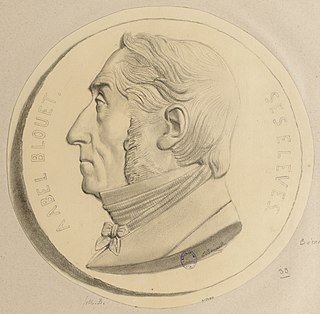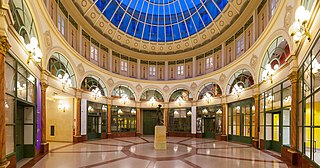Life and work
He studied at the Lycée Bonaparte (now the Lycée Condorcet), and was hired by the Ministry of State in 1866.
In 1881, he was appointed Inspector General of the fine arts schools. Five years later, he was named Director of civic buildings, in charge of the headquarters of what is now the Ministry of National Education. From that time, through 1901, he was involved in expanding the Bibliothèque Nationale. He also participated in restoration projects at the Château de Versailles, and the Domaine national de Saint-Cloud.
He was awarded the rank of Commander in the Legion of Honor in 1895. The following year, he founded the Revue de l'art ancien et moderne [ fr ], which passed to Raymond Woog upon his death.
He was elected to the Académie des Beaux-Arts in 1909, where he took Seat #2 in the "Unattached" section; succeeding Émile Michel (deceased).

Edmond Louis Antoine Huot de Goncourt was a French writer, literary critic, art critic, book publisher and the founder of the Académie Goncourt.

The 13th arrondissement of Paris is one of the 20 arrondissements of Paris. In spoken French, the arrondissement is referred to as le treizième.
The grands établissements are French public institutions under ministerial charter within the administrative category referred to as Établissements publics à caractère scientifique, culturel et professionnel (EPCSP).

Pierre-Jean Mariette was a collector of and dealer in old master prints, a renowned connoisseur, especially of prints and drawings, and a chronicler of the careers of French Italian and Flemish artists. He was born and died in Paris, and was a central figure in the artistic culture of the city for decades.

The BnF Museum or Museum of the Bibliothèque nationale de France, formerly known as the Cabinet des Médailles, is a significant art and history museum in Paris. It displays collections of the Département des Monnaies, Médailles et Antiques de la Bibliothèque nationale de France as well as manuscripts and books from the Library's collections. The BnF Museum is located in the Richelieu site, the former main building of the library bordering rue de Richelieu.
Hippolyte-Jules Pilet de La Mesnardière was a French physician, man of letters and dramatist.

Bruno Racine is a French civil servant and writer.

Guillaume-Abel Blouet was a French architect who specialised in prison design.

Étienne Martellange was a French Jesuit architect and draftsman. He travelled widely in France as an architect for the Jesuit order and designed more than 25 buildings, mostly schools and their associated chapels or churches. His buildings reflect the Baroque style of the Counter-Reformation and include the Chapelle de la Trinité in Lyon and the church of Saint-Paul-Saint-Louis in Paris. In the course of his travels he made almost 200 detailed pen drawings depicting views of towns, buildings and monuments. These pictures have survived and provide an important historical record of French towns in the first third of the 17th century.

Félix-Sébastien Feuillet de Conches was a French diplomat, journalist, writer and collector. Having occupied the posts of 'introducteur des ambassadeurs' and head of protocol at the Ministry of Foreign Affairs, he was able to form a collection specialising in English painting, 19th century French painting, the history of civilisations, the art of the Near East and the art of Asia. His contemporary Charles Monselet judged de Conches' collection as unequalled, but it included some pieces of dubious authenticity.

Louis Leygue was a French sculptor and painter. As a sculptor he worked in the traditional stone but also pioneered the use of various metals. He was particularly adept in depicting horses.

The Institut National d'Histoire de l'Art, commonly abbreviated INHA, is a French research institute, created and governed by Decree No. 2001-621, and situated in Paris. The Institute develops scientific activity and contributes to international cooperation in most fields of art history and heritage by exercising research, training and knowledge-diffusion.

Jules-Joseph Guiffrey was a 19th-century French art historian, a member of the Académie des beaux-arts.
Alfred-Isaac Pereire was a 20th-century French historian and bibliographer.
Bertrand Jestaz, 2 February 1939 in Fontainebleau, is a French art historian, specialized in French and Italian Renaissance and in French classical art.
Madeleine Laurain-Portemer was a 20th-century French historian, specializing in the history of Mazarin and his time, married to Jean Portemer (1911–1998).

Jean-Michel Leniaud is a French historian of art. A specialist of architecture and art of the 19th and 20th centuries, he was director of the École Nationale des Chartes from 2011 to 2016. He is president of the Société des Amis de Notre-Dame de Paris.
COUPERIN is an academic consortium in France. Formed in 1999, it includes more than 250 universities, research organizations, Grandes écoles (schools), COMUE, and others. The consortium negotiates with publishers the prices and conditions of access to scientific publications and other digital resources for the benefit of its members. It promotes open science, particularly with regard to scientific publications, both nationally and internationally. It is headquartered in Paris.

Philippe Chaperon was a French painter and scenic designer, particularly known for his work at the Paris Opera. He produced stage designs for the premieres of numerous 19th-century operas, including Verdi's Don Carlos and Aida, Massenet's Le Cid, Saint-Saëns's Henri VIII, part two of Berlioz's Les Troyens and the first performances in France of Verdi's Otello and Rigoletto and Wagner's Tannhäuser.
Léon Roger was a French lawyer, historian, poet, journalist and art critic.













